Water backflow is a serious issue that, when ignored or handled poorly, can both cause health issues and cost a homeowner a lot of money. With many cities passing legislation to make backflow prevention devices mandatory for any potential backflow threat, now is the time for home and business owners to learn about water backflow and how to prevent it.
What causes water backflow, and why is it dangerous?
Backflow is an unwanted reversal of water flow caused by a sudden drop or complete loss in water pressure. Instead of pushing water out of the plumbing fixture, the drop in water pressure sucks water back into the public water system, possibly contaminating the system where it connects to non-potable water.
One common backflow threat is an irrigation system. When a farmer uses irrigation to water crops, or when a homeowner uses sprinklers to maintain a lawn, if puddles form around the sprinkler device, then that water can seep back into the system. If a reversal in pressure occurs, that water, now contaminated with pesticides, fertilizer, and other toxins gets sucked back into the supply line via its output line like a straw. This distributes the toxins in this water to other households, where they might end up in drinking water for the general public, causing sickness and potentially serious health issues.
Aside from homeowners, industrial business and facilities such as car washes, dry cleaners, and restaurants are common hazards for water backflow.
In the past decades, there have been numerous documented cases where backflow contaminated water has led to illness, and even death. Water backflow is a serious issue and anybody dealing with non-potable water that could possibly flow back into the public water system has to make sure to prevent such a dangerous situation from ever happening.
How can I prevent Water Backflow?
Backflow prevention devices prevent contaminated water from flowing from your public water system into your supply line. With a backflow prevention device in place, your plumbing will be able to detect events that cause contamination, and prevent them from affecting your water supply.
Many cities have already passed legislation making backflow preventers mandatory for many homeowners and industrial businesses which deal with non-potable water that could flow back into the public water system.
Backflow prevention devices are available in five forms, differing in complexity, effectiveness, and intended purpose.
Air gaps
By using a vertical air-gap, air gaps prevent water from flowing back into the dispensing system. Air gaps are often used in toilets and faucets, separating the home’s supply line from the sewage line.
While air gaps are a simple, effective solution to prevent backflow, they are only practicable for a narrow range of products. In many systems other than toilets and faucets (such as in solutions for industrial purposes, irrigation systems, or systems preventing backflow from houses into the public water system), an air gap backflow preventer is impossible for practical and design related reasons.
Atmospheric Vacuum Breakers
Atmospheric vacuum breakers are ideal for homeowners that want to separate a single backflow threat from the public water system. Using a vacuum breaker to shut off the water connection when the pressure drops too low, this simple device combines cost efficiency with easy maintenance.
Pressure Vacuum Breakers
The pressure vacuum breaker is a more sophisticated version of the atmospheric vacuum breaker. Generating its own pressure to separate two water systems instead of relying on air pressure, this system is more effective and offers a wider range of uses. The downside to this system’s sophistication is that it requires annual testing.
Check Valves
Check valves come in the form of single check valves (for less critical contamination hazards) and as double check valves (for more significant health hazards). Both types of check valves are inline devices that can be used underground, allowing them to be installed in the least visible way – a quality many homeowners cherish. Check valves are an effective solution for many homes, but fail to filter out all hazardous chemicals, making them insufficient for industrial use. Check valves also require annual testing.
Reduced Pressure Principle Assemblies
Reduced pressure principle assemblies are the most sophisticated system for preventing water backflow, making them an effective solution for businesses and homes with significant water hazards. In addition to using two check valves, the reduced pressure principle assembly also uses a depressurized zone that prevents water backflow even if a valve fails. The reduced pressure principle assembly requires annual testing.
How to get the right Backflow Prevention System
To install an effective system, choosing the right method of backflow prevention is crucial. With the wrong method, you waste money on an ineffective solution that fails to prevent backflow and also fails to protect you from claims for compensation.
To get an effective water backflow prevention system, you should always contact an expert plumber in Orange County. Only an expert can securely identify the ideal solution for your needs and serve you with a system that combines backflow prevention with easy maintenance and cost efficiency.
(Depending on where you live, finding an expert might not always be easy. Not all plumbers are familiar with the requirements for backflow prevention. For homeowners in Orange County, California, the experts at Biard & Crockett Plumbing Services remain one of the most experienced companies nationwide in preventing water backflow.)
